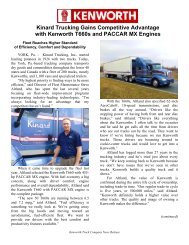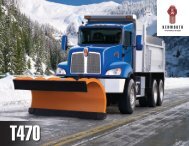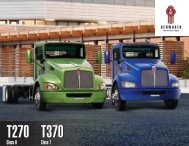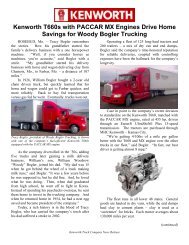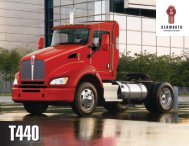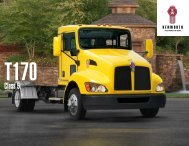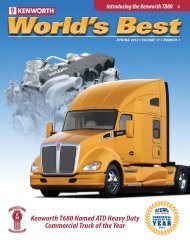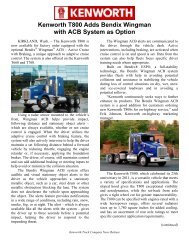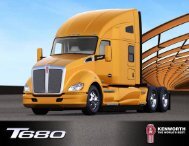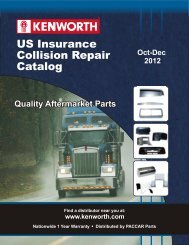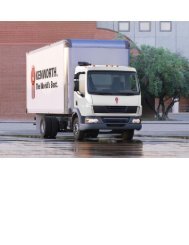2010 Kenworth T440/T470 Body Builder Manual
2010 Kenworth T440/T470 Body Builder Manual
2010 Kenworth T440/T470 Body Builder Manual
- No tags were found...
You also want an ePaper? Increase the reach of your titles
YUMPU automatically turns print PDFs into web optimized ePapers that Google loves.
Section 4<br />
Exhaust & Aftertreatment<br />
GENERAL GUIDELINES FOR DEF SYSTEM<br />
The installation of the DEF tank is a critical component of the SCR system. While <strong>Kenworth</strong> does not recommended relocating<br />
the DEF tank, there are applications and body installations that will require it. The guidelines below must be strictly<br />
followed by any entity relocating the tank. Failure to follow the guidelines completely and accurately may result in engine<br />
shutdown situations.<br />
<strong>Kenworth</strong> offers a variety of DEF tank sizes to meet every application. The DEF tank volume is regulated by the E.P.A.<br />
<strong>Kenworth</strong> advises against modifying the tank volume after the truck has been delivered from the factory.<br />
• Total DEF capacity must meet or exceed 6% of the usable fuel capacity on the truck. The calculation<br />
to determine DEF capacity is:<br />
Minimum DEF Tank Volume = Useable Fuel Capacity (gal) x 0.06<br />
Example: For a truck with 200 useable gallons of fuel, the equation is<br />
DEF required = 200 x 0.06 = 12 gallons or more of DEF.<br />
PACCAR-approved DEF hoses are required when retrofitting for system to function properly. The use of unapproved hoses<br />
for DEF lines will void warranty and may cause engine shutdown situations. The DEF pump (or Supply Module) can not be<br />
relocated from the DEF tank.<br />
INSTALLATION REQUIREMENTS AND DIMENSIONS FOR DEF SYSTEM<br />
When relocating any DEF system components, the locations must meet the guidelines below. Failure to comply may result<br />
in non-conformance to EPA standards and engine shutdown.<br />
DEF piping relative heights: In order to ensure proper functionality of DEF system, the height differences in the guidelines<br />
below must be followed during line routing and component placement.<br />
With all relocating procedures, general clearances and routing guidelines must be followed. See section 9 of this manual<br />
for general routing guidelines.<br />
When relocating the components the maximum pressure DEF hose length, from Supply module to Dosing Module, is 3<br />
meters (118”).<br />
Maintain a minimum of 3” clearance to shielded exhaust components when routing DEF lines to prevent possible melting.<br />
If the DEF tank is relocated the coolant lines will need to be modified. During this process if the tank is moved forward on<br />
the chassis (ie closer to the engine) it is necessary to remove excess coolant lines and maintain the original routing path.<br />
If the tank is moved rearward on the chassis the additional length of cooling line required to complete the installation must<br />
be installed in a straight section of the existing coolant routing lines. This process will minimizes the change in coolant flow<br />
by minimizing changes in restrictions. Increases in restriction occur with excessive line length and bends. Work with your<br />
local <strong>Kenworth</strong> dealer if you are unsure about the coolant line modifications.<br />
4-3<br />
12/09



